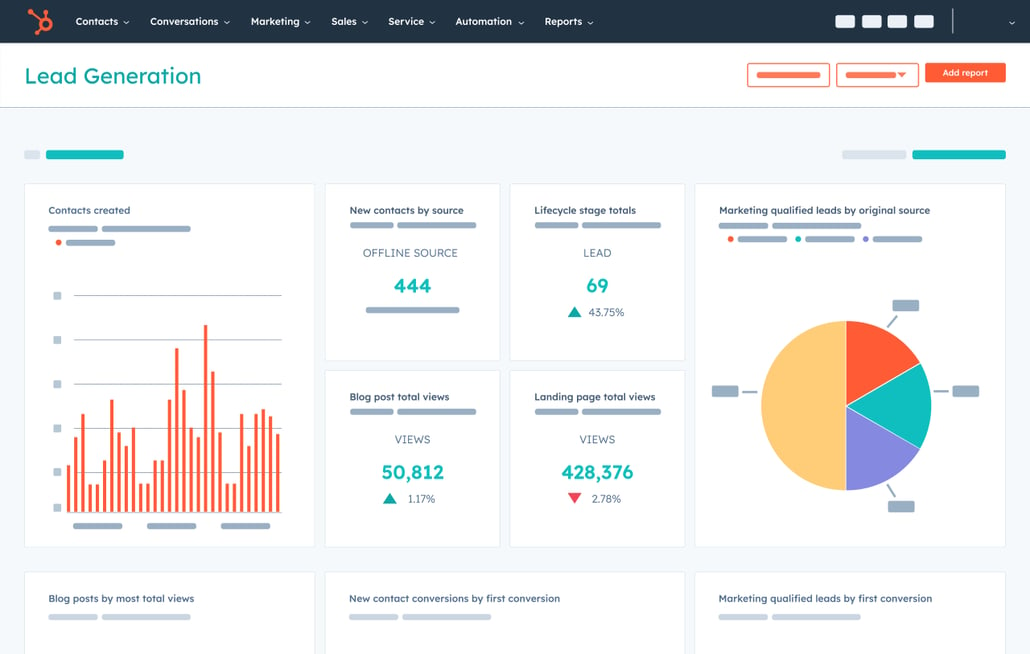If you’re planning to implement a CRM in 2025, HubSpot CRM is one of the best choices available.
It’s powerful, flexible, and helps businesses of all sizes manage sales, marketing, and customer relationships, all in one place.
In this HubSpot CRM Implementation Guide, we’ll walk you through a clear step-by-step setup process, share best practices, and help you avoid common mistakes. Whether you’re a startup or an enterprise, this guide will help you set up HubSpot CRM the right way.
What Is HubSpot CRM Implementation?
HubSpot CRM implementation means setting up HubSpot so that it fits your business process, from collecting leads to closing deals and delighting customers.
It includes:
- Setting up your company profile and team members
- Importing and cleaning customer data
- Customizing sales pipelines and properties
- Automating workflows and reporting
- Training your team to use HubSpot effectively
Think of it as building your CRM foundation if it’s strong, your entire sales and marketing engine runs smoothly.
Step-by-Step HubSpot CRM Implementation Guide
Let’s dive deeper into each step, so you can implement HubSpot confidently and correctly.
Step 1: Define Your CRM Goals and Strategy
Before you even log in to HubSpot, you need clarity on what success looks like for your CRM.
Ask yourself:
- What problem do I want HubSpot to solve? (Lead tracking, reporting, automation, etc.)
- Who will use it Sales, Marketing, or both?
- What metrics will define success? (e.g., faster lead response time, better deal conversion)
Example:
If your goal is to reduce lead leakage, you’ll want to focus on proper lead capture forms, notifications, and workflows from the start.
Once goals are defined:
- Document your sales process stages.
- Map your customer journey.
- Decide which teams will own which parts of HubSpot.
Step 2: Set Up Users, Permissions, and Pipelines
After defining goals, it’s time to structure your CRM.
- Add team members:
Go to Settings → Users & Teams and invite everyone who’ll use HubSpot.
Assign roles (Sales Rep, Manager, Admin) to control permissions. - Create custom properties:
These are data fields you’ll use to capture key info (like “Lead Source” or “Deal Value”).
Keep them relevant, too many can confuse your team. - Set up sales pipelines:
Navigate to Settings → Objects → Deals → Pipelines.
Define your deal stages such as:- New Lead
- Contacted
- Demo Scheduled
- Negotiation
- Closed Won/Lost
Tip: Align these stages with your actual sales process, not a default template.
Step 3: Clean and Import Your Data
Poor data equals poor results.
Before importing:
- Export your old CRM data (like from Salesforce, Zoho, or Excel).
- Remove duplicates and outdated records.
- Standardize names, emails, and company info.
Then:
- Go to Contacts → Import → Start an Import.
- Use HubSpot’s CSV templates for clean mapping.
- Test a small batch before importing all data.
Pro tip: Add tags or labels (e.g., “Old CRM,” “2024 Leads”) to know where data came from.
Step 4: Integrate HubSpot with Your Tools
HubSpot works best when it’s connected to your existing tools.
Integration ensures that marketing, sales, and support stay aligned.
Common integrations include:
- Email & Calendar: Gmail, Outlook
- Website: WordPress, Webflow, or HubSpot CMS
- Marketing Tools: Google Ads, Facebook Ads, LinkedIn Ads
- Customer Service: WhatsApp, Live Chat, or Helpdesk apps
Example:
If you integrate HubSpot with Gmail, every email you send can automatically be logged under the contact record, saving hours of manual data entry.
Step 5: Automate Workflows and Notifications
This is where HubSpot shines ✨
Automation helps your team save time and stay consistent.
You can automate:
- Lead assignments: Automatically assign new leads to sales reps.
- Email follow-ups: Send reminders or nurture emails automatically.
- Task creation: Create tasks when a deal moves to a new stage.
- Notifications: Alert team members when leads engage with emails or forms.
Tip: Start with 2–3 essential workflows. Test them, measure results, then expand.
Step 6: Create Dashboards and Reports
Now that your data is flowing, it’s time to make sense of it.
Go to Reports → Dashboards to create visual overviews of:
- Deals closed this month
- Leads generated by source
- Conversion rates by sales rep
- Email and campaign performance
Best practice: Build one dashboard for each team (Sales, Marketing, Support) so everyone focuses on relevant KPIs.

Step 7: Train Your Team for Success
The best CRM setup fails without proper training.
Make sure everyone knows:
- How to log activities and update deal stages
- How to use filters, lists, and reports
- What data fields are mandatory
Training ideas:
- Record short Loom walkthroughs
- Create a shared Google Doc with your internal HubSpot rules
- Use HubSpot Academy for free, structured lessons
Pro tip: Set adoption KPIs (like “Log 90% of deals weekly”) to encourage accountability.
Common Mistakes to Avoid During Implementation
- Skipping data cleanup leads to messy records and duplicates.
- Adding too many custom fields confuses your users.
- Ignoring user permissions can lead to privacy issues.
- Over-automating too early test before scaling.
- Not reviewing dashboards regularly outdated metrics mislead teams.
Best Practices for Long-Term HubSpot CRM Success
- Review workflows quarterly: Ensure automations still align with your business process.
- Use lead scoring: Prioritize the most engaged contacts.
- Document your setup: Helps onboard new hires quickly.
- Integrate marketing & sales: Align both teams under shared dashboards.
- Regularly clean your database: Delete inactive or bounced contacts.
HubSpot CRM Implementation Checklist
| Step | Task | Done |
|---|---|---|
| 1 | Define CRM goals and KPIs | OK |
| 2 | Add users and create pipelines | OK |
| 3 | Clean and import data | OK |
| 4 | Integrate tools (email, website, ads) | OK |
| 5 | Set up automation workflows | OK |
| 6 | Create dashboards and reports | OK |
| 7 | Train and onboard your team | OK |
Frequently Asked Questions (FAQ)
Q1. What is HubSpot CRM implementation?
It’s the process of setting up and customizing HubSpot CRM to manage customer relationships, automate workflows, and track business performance.
Q2. How long does it take to implement HubSpot?
On average, 2–4 weeks depending on company size, team readiness, and data migration needs.
Q3. Can I migrate from another CRM to HubSpot?
Yes, HubSpot supports easy imports from Salesforce, Pipedrive, Zoho, and spreadsheets.
Q4. Do I need a partner agency for implementation?
Small businesses can set up HubSpot internally, but larger teams benefit from working with a certified HubSpot Partner for advanced workflows.
Final Thoughts
A successful HubSpot CRM Implementation is not just about setting up software, it’s about transforming how your teams work together.
When implemented correctly, you’ll enjoy:
- Organized and accurate data
- Streamlined lead and sales processes
- Improved customer engagement
- Smarter decision-making with reports
Start small, optimize as you go, and let HubSpot grow alongside your business.
About the Author
Widelly
widelly-admin · 11 articles published
Expert contributor at Widelly, sharing insights on B2B and B2C growth strategies.


